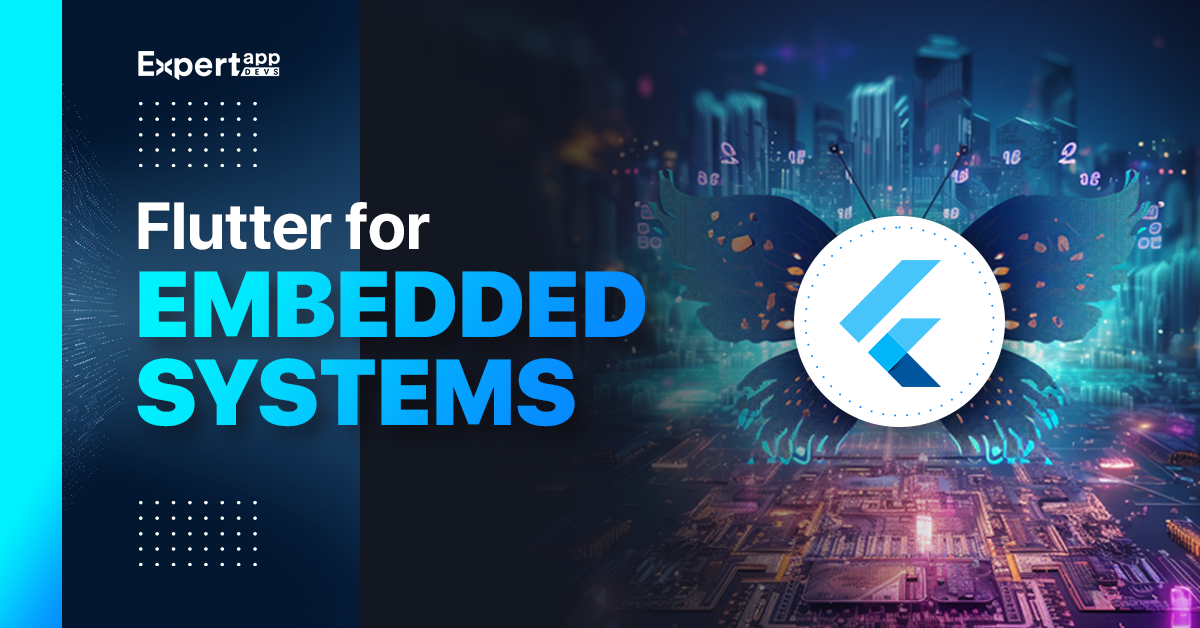Why Use Flutter for Embedded Systems?
Flutter has been in trend since its inception. It is a Google-powered, Dart-based cross-platform mobile app development framework. It is one of the most preferred cross-platform platforms used for mobile app development. Recently, businesses also have started using Flutter for embedded systems. Thanks to its cross-platform compatibility, not just new startups and medium-scale enterprises, but giant companies are also shifting their gears towards Flutter for their embedded product development projects.
What Are Embedded Systems?
As the name suggests, an embedded system is a combination of software and hardware used to perform a specific task within a system. Now, it might be an independent system or a part of a more comprehensive system with other components, such as microprocessors or microcontrollers. Most embedded systems also have an integrated circuit to perform various tasks, such as computations for real-time operations.
Software development uses A Graphical User Interface to make interactions with electronic devices possible. Here, electronic devices are computers, smartphones, tablets, and other devices. A GUI makes interactions possible through various icons, menus, visual indicators, and representations, generally graphics. A GUI is not a text-based interface but uses graphical displays to share information and other relevant user controls.
Thanks to GUIs, computers and other digital technologies are more accessible to laymen with almost zero knowledge of technology. Programmers use GUIs due to their user-centric designs and other benefits that they have to offer to them.
Embedded GUIs are popular as they can design highly user-friendly and easy-to-use controls for embedded systems. It is a software interface that can be used on embedded systems, allowing users to control and monitor the system through graphical and visual components, such as text fields, buttons, and icons.
A study by Market Research Future (MRFR), the embedded GUI development software market will grow at a rate of 25.9% from 2022 to 2030.
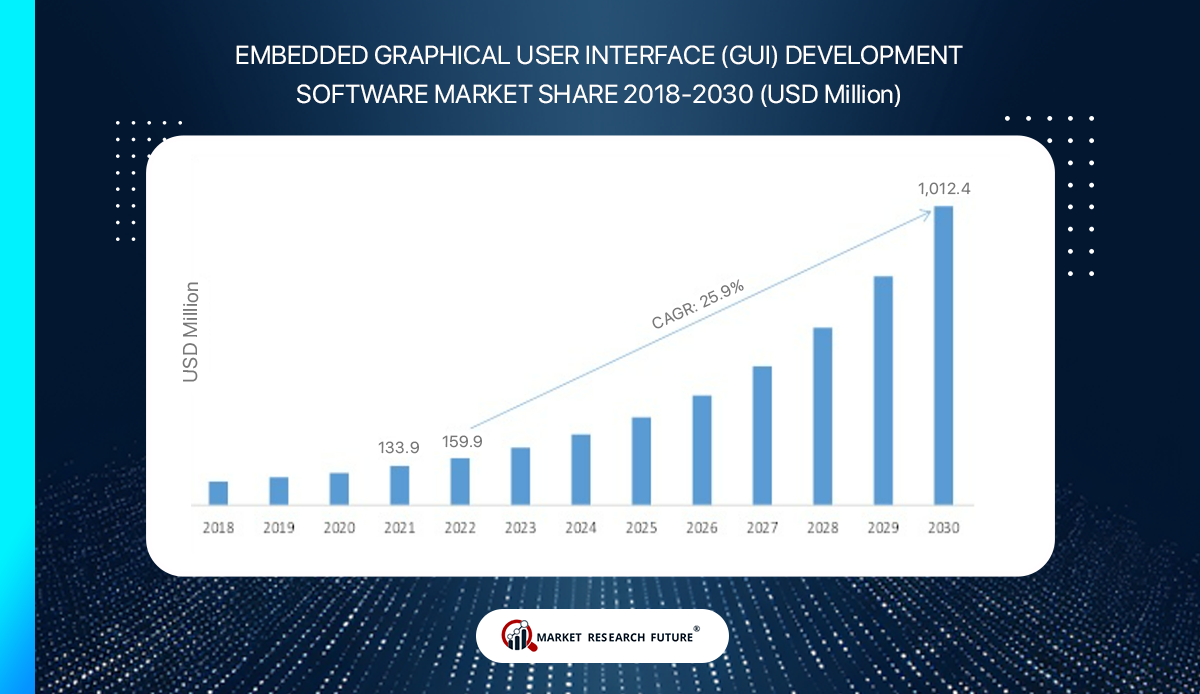
Also, the same report reveals that the market size will cross $1,012.4 million by 2030.
What is Flutter?
As discussed, Flutter is one of the most preferred cross-platform mobile app development frameworks. It is Google's brainchild and offers some magnificent benefits to developers and businesses.
What do developers achieve with Flutter app development? Flutter makes the development process streamlined and highly efficient, reduces the app-to-market time, and reduces costs.
Flutter can be used to develop native and cross-platform mobile apps with a single codebase. It has a comprehensive Software Development Kit and a widget-based UI library. With an SDK, developers can easily compile their code into native machine code.
Not just that, you can also build highly responsive and scalable desktop and web apps using Flutter. A report reveals that 46% of developers use Flutter for cross-platform app development.
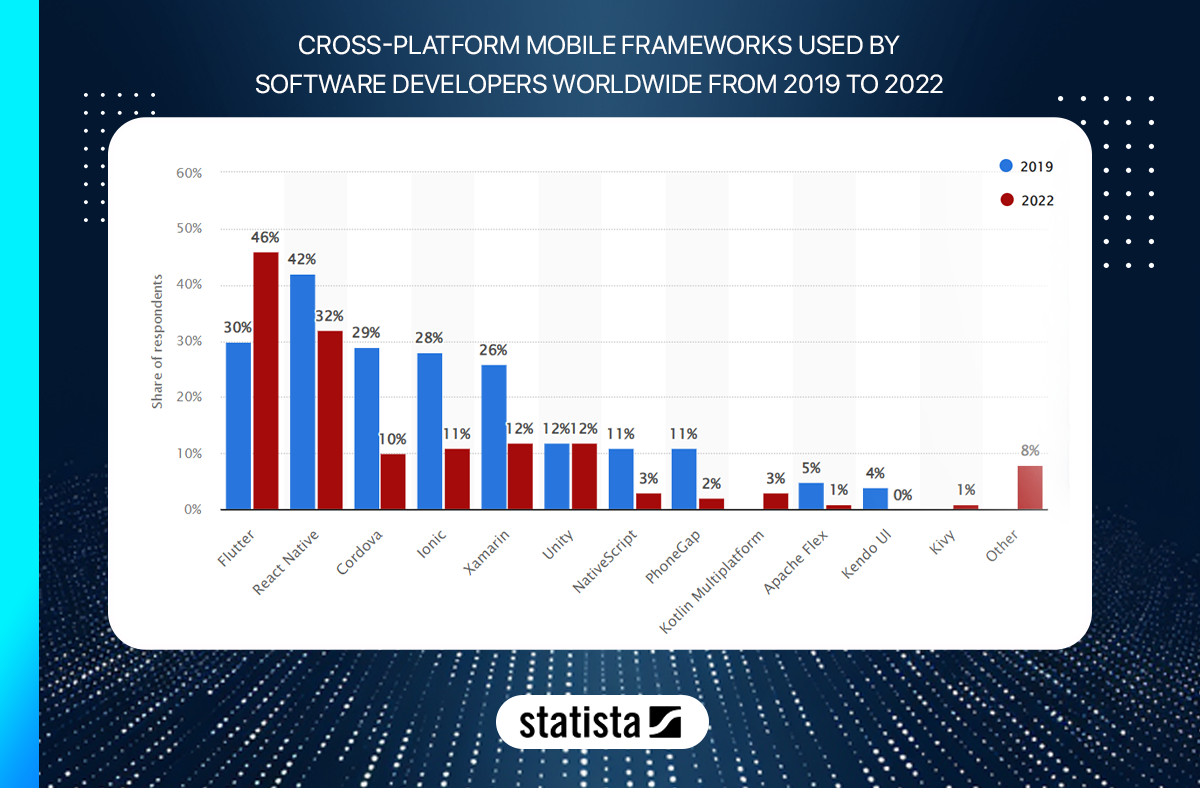
Key Features of Flutter
Flutter is popular due to some key features that make the development process simple, efficient, and streamlined.

#1. Hot Reload Feature
With the Hot Reload feature, developers don't have to reboot the entire app to make changes. They can make changes to the code and watch them in real-time how the code behaves.
#2. Pixel Rendering Feature
This feature allows widgets to look similar on any device, as Flutter ensures pixel management on every screen. Hence, the user interfaces of the apps will look the same on Android and iOS platforms.
#3. Robust Documentation
Developers have robust documentation and resources to rescue them whenever they have any development issues or queries.
#4. UI Components
Flutter has some excellent UI components and rich widgets that help develop high-end, robust, intuitive, and superior user interfaces for mobile apps.
Transitioning from Mobile to Embedded Systems: Challenges and Benefits
The market for embedded systems is growing in leaps and bounds. Developing a mobile app for embedded systems is exciting, but it is not all glitter.
The main complexity is growing demands from users who want iPhone-like interfaces and advanced features. Embedded systems have GUIs that run on touchscreens with the Linux operating system. For Qt developers, the transition from mobile to embedded systems might be challenging as they must first understand GUI development.
Some of the challenges are discussed here:
- Developers must learn to design complex, larger, highly distributed embedded systems.
- Developers sometimes have to work with fewer resources than mobile app development.
- Developers also have to work closely and collaborate with user interface development teams.
- Also, they have to build or configure their operating systems.
- They must also learn how to use software development kits and cross-development tools.
- As embedded systems require high reliability, developers face challenges in quality assurance, documentation, and the process.
- There is limited scope for updates and upgrades in embedded systems. Hence, developers have to test systems thoroughly. There is no scope for mistakes, errors, and mishaps.
Benefits of the transition from mobile to embedded systems:
- Developing embedded systems requires fewer resources.
- Embedded system development is cost-effective.
- Embedded systems are highly steadier and offer good speed.
- They are versatile due to their sizes.
- They provide higher dependency and good performance.
What are Embedded Systems and GUIs?
The main aim behind designing an embedded system is to perform specific tasks within larger systems. Here, one device is embedded with another to perform specific tasks and execute particular functions. This device can be home appliances, automobiles, machinery, and others. Embedded devices are highly optimized for real-time efficiency, reliability, versatility, and high-end responses.
Developing an embedded system requires hardware components, input/output interfaces, memory, and other components. Here, microprocessors and microcontrollers are hardware components. As embedded systems have limited processing power, battery life, storage capacity, and memory, you will be required to develop high-end software to meet the demands and expectations of the users.
Embedded Graphical User Interfaces (Embedded GUIs) are explicitly designed to offer end users an impressive look and feel. It is a software interface used on an embedded system to carry out various tasks. Users can easily control and manage the system with multiple graphics, icons, buttons, sliders, etc.
Take an example of a sports watch. You will need a responsive, impressive, and power-efficient GUI to display a wide range of information, such as steps, health stats, text messages, and other vital features.
Traditional Approaches to Building GUIs for Embedded Systems
Developing a GUI is inevitable for embedded systems. These GUIs can help users to interact with the devices and systems seamlessly and intuitively. All you need is a team of professionals good at GUI development. State your requirements and let them leverage their expertise to build robust, interactive, and resourceful GUIs.
Traditionally, developing GUIs for embedded systems was more challenging than today. It was a challenging and resource-intensive task. Earlier, the demand for visually impressive and appealing GUIs was low.
However, the scenario has changed completely today. Today, you can have aesthetically appealing GUIs with highly advanced features and functionalities. The main benefit of developing such GUIs is that users can connect instantly with the device or system.
Languages Used for Embedded App Development
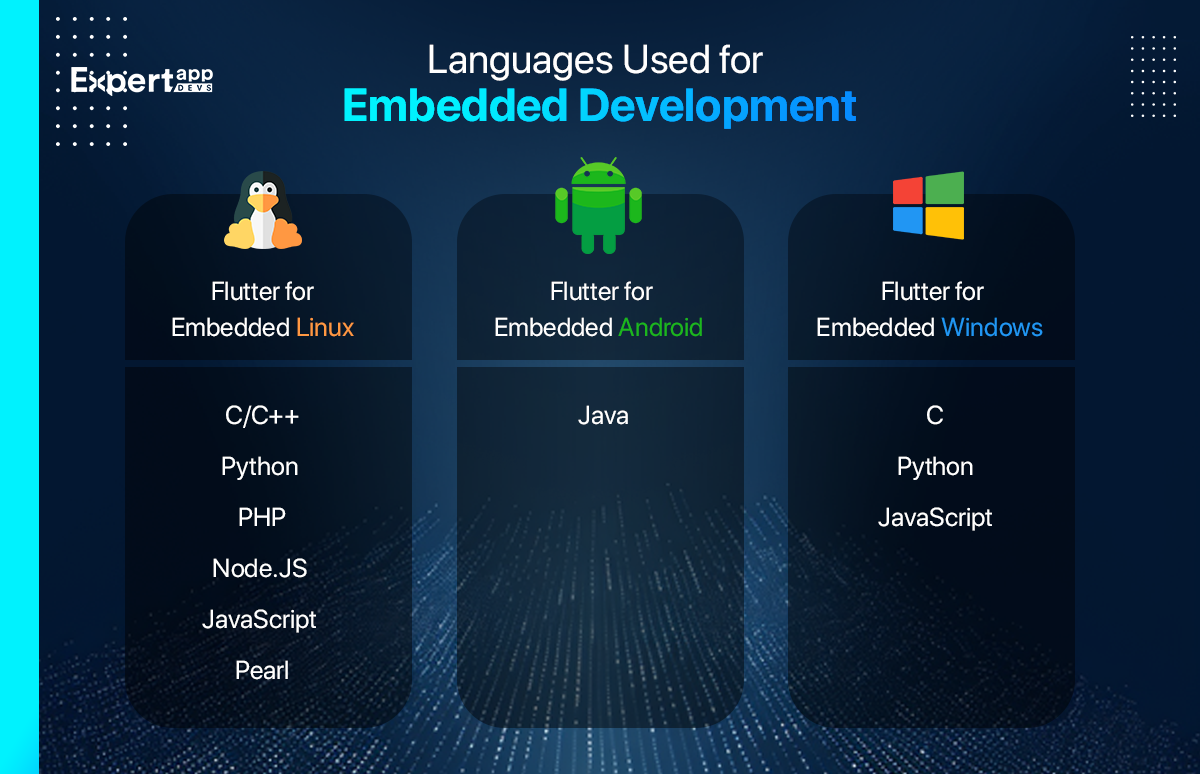
Flutter for Embedded Linux
You can use various programming languages for Embedded Linux development. Mostly, developers prefer programming languages such as C/C++, Python, PHP, Node.JS, JavaScript, and Pearl.
Flutter for Embedded Android
For embedded Android development, the first choice of language is Java. The main reason for choosing Java is that once the developer has written the code in an embedded system, they can easily port it to another device without any hassles.
Flutter for Embedded Windows
For embedded Windows development, programmers use C, Python, and JavaScript.
Advantages of Using Flutter in Embedded Systems
Using Flutter in embedded systems can offer many benefits to programmers and end-users. Let's discuss them in detail:
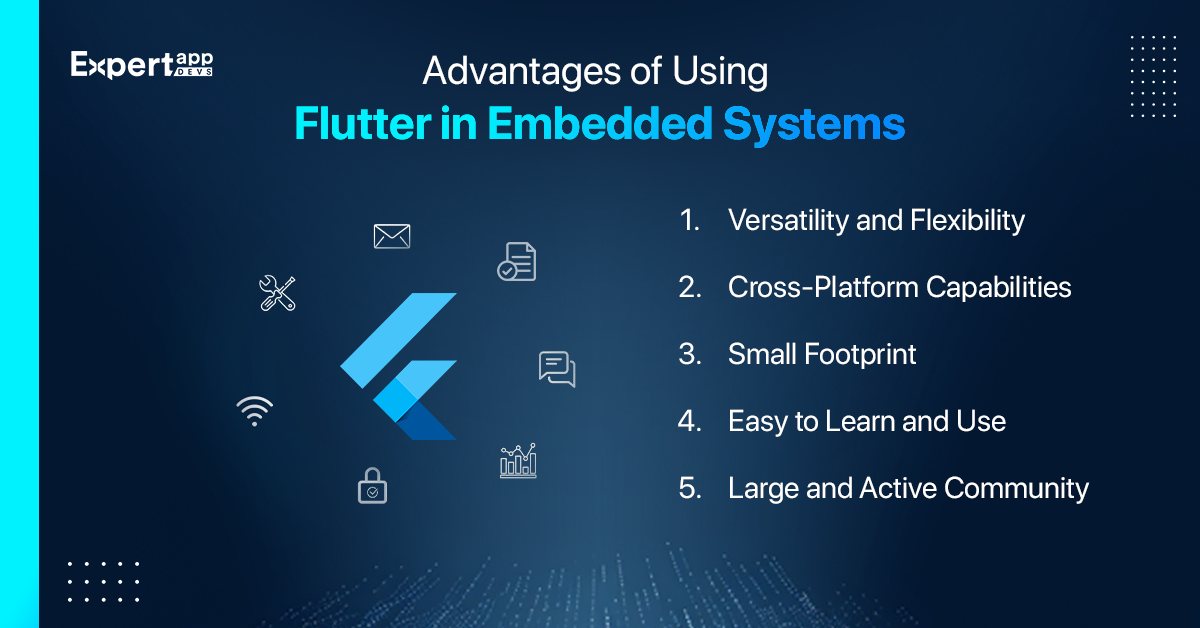
#1. Versatility and Flexibility
Flutter is one of the most versatile and flexible cross-platform app development frameworks. These qualities make Flutter an ideal choice for embedded app development.
#2. Cross-Platform Capabilities
Flutter allows developers to write a single codebase and use it to develop apps for various operating systems, such as Android, iOS, and Windows.
#3. Small Footprint
You will need a lightweight app as embedded systems have limited processing power. Flutter is lightweight and has a small footprint. Also, it can run on low-power hardware, making it a perfect choice for embedded systems.
#4. Easy to Learn and Use
Flutter is an easy framework to learn and use. It uses Dart as a programming language. Dart is a modern, object-oriented programming language like JavaScript. Flutter app development is time-saving, cost-effective, and accessible.
#5. Large and Active Community
Flutter has a large community of developers updating documents and other resources. Flutter developers can easily reach out to them in case of any queries.
Components of an Embedded System
An embedded system has three primary components- hardware, software, and user interface.
Hardware:
An embedded system is made of various hardware components such as microprocessors, microcontrollers, sensors, memory, power supply, and others. These hardware components perform specific tasks and interact with the system environment.
Software:
Software components are algorithms and programs used to control the hardware components. Some software components are drivers, operating systems, application software, etc. These components also communicate with external devices and manage system resources.
User Interface:
End-users use the user interface to interact with the embedded system. The UI has mainly input/output devices such as displays, touchscreens, buttons, etc. The UI should be intuitive, uncluttered, and impressive to woo your end-users.
Apart from these components, an embedded system also has security features, networking features, and communication protocols.
Features of Embedded Systems
Here is a list of features of embedded systems:
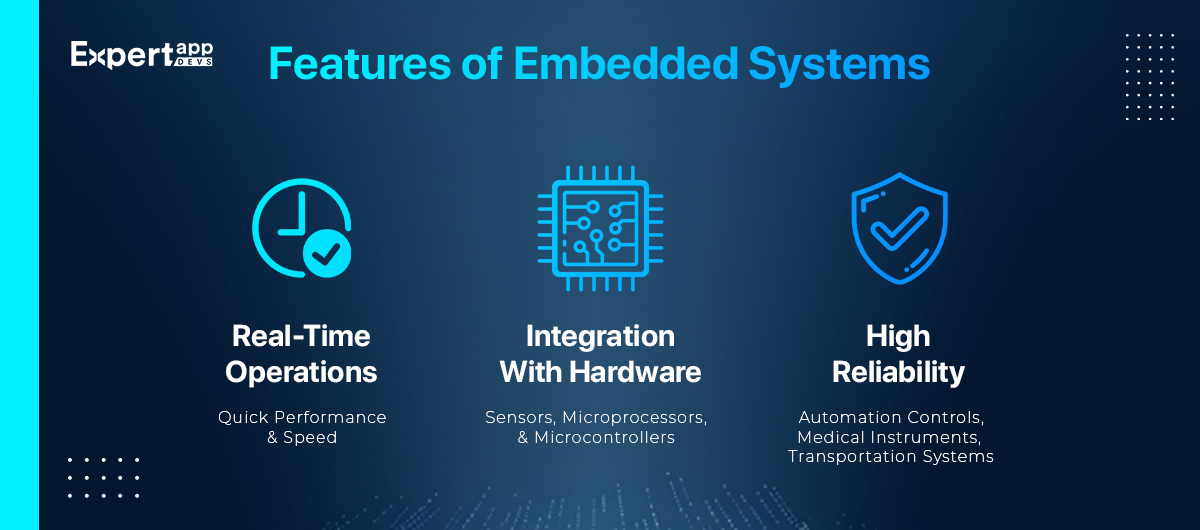
#1. Real-Time Operations
Embedded systems must respond to queries in real time. That's why they must process data quickly and accurately. Ensure that the embedded system you design for your app offers seamless and quick performance and speed.
#2. Integration with Hardware
Embedded systems are integrated closely with various hardware components, such as sensors, microprocessors, and microcontrollers.
#3. High-Reliability
Mainly, embedded systems are used in operations where reliability is vital. Some examples are industry automation controls, medical instruments, transportation systems, etc.
Challenges of Using Flutter in Embedded Systems
You might face various challenges while using Flutter in embedded systems. Though Flutter is an excellent choice for embedded systems, you must consider these challenges.
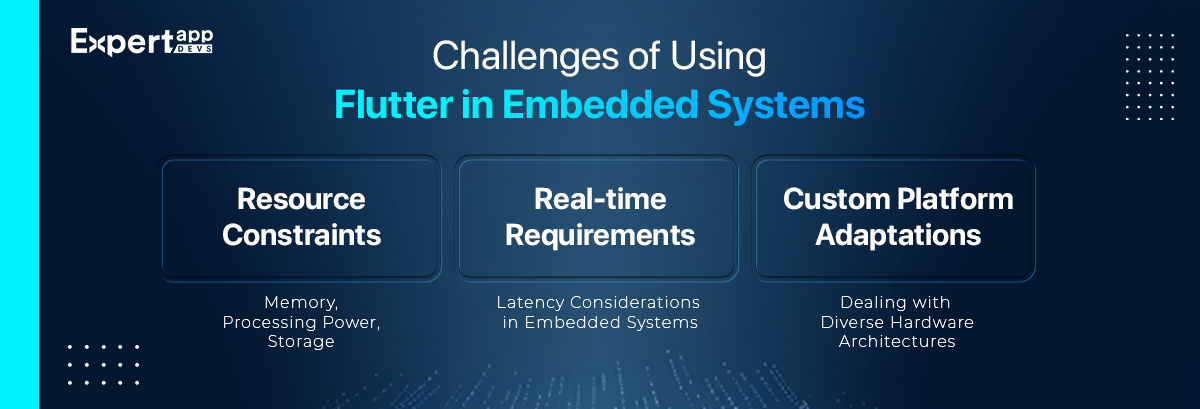
#1. Resource Constraints: Memory, Processing Power, Storage
Embedded systems have limited resources, such as limited processing power, memory, and storage capability. It might be a challenge for developers to overcome these constraints while using Flutter for embedded systems.
#2. Real-time Requirements: Latency Considerations in Embedded Systems
Embedded systems must respond in real time. Hence, they must carry out various tasks instantly and with high accuracy. This is a special consideration to think about while using Flutter.
#3. Custom Platform Adaptations: Dealing with Diverse Hardware Architectures
An embedded system might need to adapt to various platforms and operating systems with diverse hardware architectures. Discuss these challenges with the Flutter app development company you hire.
Why did Toyota choose Flutter Embedded Systems?
Toyota was the first company that use Flutter for embedded systems. There are various reasons why Toyota embraced Flutter. First, they want to offer the best-in-class driving experience to their users. Furthermore, Flutter has extended capabilities, making it the best framework for embedded systems.
Here are the reasons why Toyota chose Flutter for embedded systems:
- Flutter offers excellent performance with a user interface similar to mobile apps, thanks to its features, such as AOT compilation and rendering engine.
- Flutter's touch mechanics are great and similar to mobile touch screen interactions, thanks to Wayland and X11 display server protocols.
- Flutter offers cross-platform compatibility, allowing developers to write a single codebase for various operating systems.
- Flutter allows developers to build world-class in-vehicle software that gives users the best time and experience.
Examples of Embedded Systems that can be Developed using Flutter
#1. Smart Home Automation
Flutter can be used to develop intelligent home automation systems that use embedded devices such as sensors, cameras, switches, and others. You can perform various automated tasks such as switching on/off TVs, monitoring security cameras, adjusting thermostats, opening or closing doors, etc. Flutter allows to building of highly impressive user interfaces to control devices efficiently and quickly.
#2. Medical Devices
You can develop apps for various medical and surgical equipment and devices, such as heart rate monitors, blood glucose monitors, etc. Here, embedded systems can collect, process, and analyze data, and Flutter can display data with the best user interfaces.
#3. Industrial Automation
Various industry automation systems use embedded devices. You can develop an app to control these devices accurately and efficiently. Some devices are sensors, programmable logic controllers, display machines, etc. You can easily control various manufacturing processes with a single app developed with Flutter.
#4. Smart Agriculture
You can develop an app to help monitor and control various smart agriculture systems using sensors and weather stations. Farmers can monitor the soil moisture levels, humidity, temperature, and other things to make highly data-driven decisions.
#5. Wearable Devices
Fitness trackers and smartwatches use embedded devices that collect user data. Flutter can be used to develop apps that offer an intuitive and impressive user interface.
Getting Started with Flutter for Embedded Systems
Now, let's discuss how to kickstart your project to use Flutter for embedded systems.
How to Set up the Development Environment?
Just visit the Flutter Installation Guide to learn more about setting up the development environment.
How to Choose the Right Hardware Platform?
You must choose a hardware platform that perfectly supports Flutter for embedded systems. Mostly, developers choose Raspberry Pi. However, some developers also go for BeagleBone. You can check out other Flutter Supported Platforms as well. Discuss with the team of the Flutter app development company to choose the right platform.
Basics of Designing User Interfaces with Flutter
Flutter mainly uses widgets, and basic building blocks, to create impressive user interfaces.
#1. Widgets:
There are two types of widgets: StatelessWidget and StatefulWidget.
StatelessWidgets are used for unchangeable components. On the other hand, StatefulWidgets are used for components that have dynamic behavior.
#2. Layouts:
Layout widgets are used to arrange user interface elements. Some of the layout widgets are:
- Container: This widget can contain other widgets and offer styling to them.
- Column and Row: These widgets arrange children's components vertically or horizontally.
- Stack: This widget allows developers to overlap multiple widgets.
#3. Widgets and UI Elements:
Flutter also has widgets for various UI elements, such as buttons, text fields, images, etc.
- Text: This widget displays text on the screen.
- Image: This widget displays images.
- FlatButton, RaisedButton, IconButton: You can use different buttons while developing user interfaces.
- TextField: It is a widget for text in Input fields.
- ListView: Developers use this widget to display scrollable lists.
#4. Animations:
You can also incorporate animations to make your Flutter UI more impressive and interactive. You can use two widgets, Animation and AnimationController, to control animations.
Optimizing Performance for Embedded Systems
Performance optimization is vital for embedded systems to offer unparalleled user experience to end-users. Also, it helps users to get instant results in real-time. How can you optimize the performance of embedded systems? Let's discuss.
#1. Memory Optimization
Hire experienced developers who are good at conducting standard coding practices. When you have high-quality code, you can minimize memory usage to a great extent. It will improve the performance and efficiency of the embedded systems.
#2. Profiling and Benchmarking
Various profiling and benchmarking tools are available that developers can use to identify performance issues. Flutter has in-built profiling and benchmarking tools such as Dart Observatory and Flutter DevTools to optimize performance and identify app performance problems.
#3. Efficient UI Updates
Another trick to optimizing performance is designing and implementing various resource-efficient UI update strategies.
Realizing Real-time Requirements
Millennials don't just require products or services; they want gratification. Their real-time requirements must be matched by the solutions you offer. How to meet real-time demands?
#1. Sensor Integration
You can integrate various sensors that can collect real-time data from the devices. You can use such data to understand and address the demands of your users. Also, you can make user-centric business decisions with such valuable data insights.
#2. Synchronization Challenges
You must also address various synchronization and coordination challenges in UI-driven applications.
Future Trends and Possibilities
Flutter is a trendsetter framework, especially in developing embedded systems. The future is promising for Flutter app development for embedded systems
Embedded systems are vital for various industry verticals such as automotive, medical & healthcare, agriculture, industry automation, aerospace, consumer electronics, and others. The endless capabilities of Fllutter can overcome some limitations of embedded systems. Together, they can offer end-users a highly satisfying, accurate, and superior performance.
As we discussed, Toyota and other brands have already embraced Flutter for embedded systems. More brands will follow in their footsteps in the future. However, you must not forget some considerable limitations of embedded systems, such as resource constraints, domain requirements, and low-level hardware interactions.
Flutter developers are constantly evolving this robust framework. It indeed will ensure improved embedded support. Not just that, predicted hardware advancements will also lead to robust and ricker embedded GUI development.
Another important technology that will bring tremendous opportunity for using Flutter for embedded systems is the Internet of Things. The growing IoT landscape will also expand, and Flutter will play a significant role.
Conclusion
Flutter is a Google-powered cross-platform development framework with rich widgets and community support. Developers can use Flutter to build embedded systems that improve efficiency, productivity, and accuracy.
Choosing Flutter to develop an embedded system is an intelligent decision. You can leverage Flutter's flexibility, versatility, performance, and endless customization possibilities to build highly robust, scalable, and tailored embedded systems that offer a seamless experience to users.
Expert App Devs is one of the Top 10 Flutter app development companies in India offering highly innovative and scalable Flutter solutions for Android, iOS, and Windows. If you want to develop Flutter for embedded systems, connect to our representative now, and we will take it forward from there.
 Jignen Pandya
Jignen Pandya
